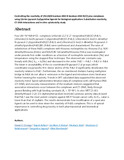Controlling the reactivity of [Pd-(II)(N boolean AND N boolean AND N)Cl] plus complexes using 2,6-bis (pyrazol-2-yl)pyridine ligands for biological application: Substitution reactivity, CT-DNA interactions and in vitro cytotoxicity study
Date
2020-12Author
Onunga, Daniel O
Bellam, Rajesh
Mutua, Gershom K
Sitati, Meshack
BalaKumaran, Manickam D
Jaganyi, Deogratius
Mambanda, Allen
Metadata
Show full item recordAbstract
Four [(N^N^N)Pd(II)Cl]+ complexes [chloride-(2,2':6',2''-terpyridine)Pd(II)]Cl (PdL1), [chlorido(2,6-bis(N-pyrazol-2-yl)pyridine)Pd(II)]Cl (PdL2), [chlorido(2,6-bis(3,5-dimethyl-N-pyrazol-2-yl)pyridine)Pd(II)]Cl (PdL3) and [chlorido(2,6-bis(3,5-dimethyl-N-pyrazol-2-ylmethyl)pyridine)Pd(II)]BF4 (PdL4) were synthesized and characterized. The rates of substitution of these Pd(II) complexes with thiourea nucleophiles viz; thiourea (Tu), N,N'-dimethylthiourea (Dmtu) and N,N,N',N'-tetramethylthiourea (Tmtu) was investigated under pseudo first-order conditions as a function of nucleophile concentration [Nu] and temperature using the stopped-flow technique. The observed rate constants vary linearly with [Nu]; kobs = k2[Nu] and decreased in the order: PdL1 > PdL2 > PdL3 ≫ PdL4. The lower π-acceptability of the cis-coordinated N-pyrazol-2-yl groups (which coordinates via pyrazollic-N π-donor atoms) of the PdL2-4 significantly decelerates the reactivity relative to PdL1. Furthermore, the six-membered chelates having methylene bridge in PdL4 do not allow π-extension in the ligand and introduces steric hindrance further lowering the reactivity. Trends in DFT calculated data supported the observed reactivity trend. Spectrophotometric titration data of complexes with calf thymus DNA (CT-DNA) and viscosity measurements of the resultant mixtures suggested that associative interactions occur between the complexes and CT-DNA, likely through groove binding with high binding constants (Kb = 104 M-1). In vitro MTT [3-(4,5-dimethylthiazol-2-yl)-2,5-diphenyltetrazolium bromide] cytotoxic activity data showed that PdL1 was the most potent complex against MCF7 breast cancer cells; its IC50 value is lower than that of cisplatin. The results demonstrate how modification of a spectator ligand can be used to slow down the reactivity of Pd(II) complexes. This is of special importance in controlling drug toxicity in both pharmaceutical and biomedical applications.
URI
https://doi.org/10.1007/S42452-020-03694-Yhttps://pubmed.ncbi.nlm.nih.gov/33011625/
http://r-library.mmust.ac.ke/123456789/1564
Collections
- Gold Collection [989]

